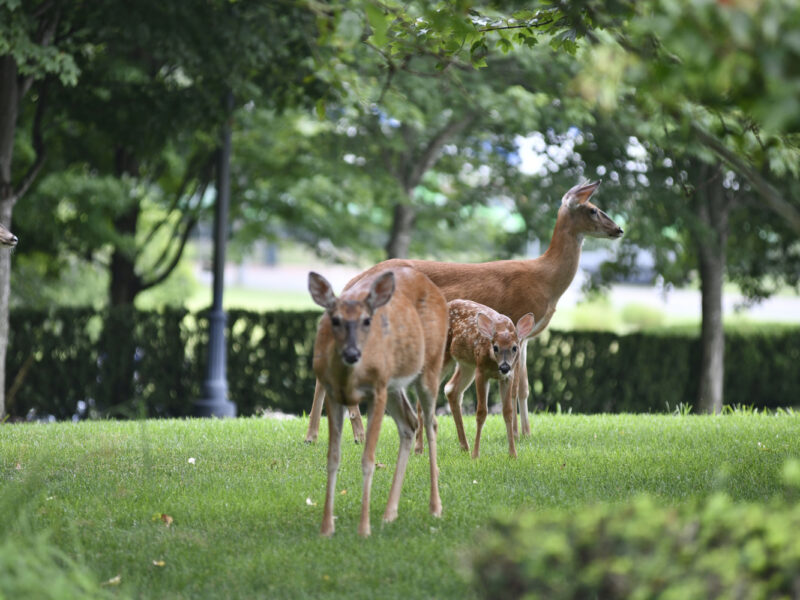
Long Island is a pretty big area, 100 miles long by up to 50 miles wide. It’s not the way it was before the builders went crazy.
We once had prairie chickens, passenger pigeons and heath hens galore. Now, the Hempstead Plains is no longer, and if it weren’t for the five eastern towns, we might not have any wild creatures left at all. Thank God we are surrounded by broad beaches, where houses don’t survive unless built behind them, and New York State’s wetland laws protect most of the wetlands from filling and building.
And, strangely, we still have most of our macrofauna, with a few additions from the south, north and overseas.
We don’t have a single native lizard, but we do have several frog and toad species, as well as four native salamanders. Gone are passenger pigeons, prairie chickens and heath hens, but in their places are species that have moved in, like the ring-necked pheasants, mallard ducks and two kinds of egret species.
But mammals, save for bats, don’t fly in to reclaim a lost territory — they have to get here by hook or crook, and many of those lost have never returned. The white-tailed deer is our largest wild mammal, and it is holding its own, population-wise. We once had wildcats, and Long Island Native Americans kept wolves as pets, but no longer.
The red fox occurred here naturally, but those English fox hunters imported their own red fox to Long Island, so there’s been a mix-up of the two forms. For the last 30 years or so, foxes have been mostly sick with the mange and very few now survive. The gray fox, however, has kept to itself. You may find a few in Montauk. It hasn’t been laid to waste by the mange to the degree that the red fox has.
One might say that among the carnivores, weasel family members have done the best: We still have two species of weasels, a mink or two, and, skunks, although you don’t smell them here and there while driving Long Island roads to the degree that one used to. Although I smelled one or two in the last five years, I have only heard of two skunks on Long Island seen by reputable witnesses — one of them in Montauk — in the last nine or 10 years.
I’m told that we have a few mink left. The young man who now looks after the wild stocks in the Peconic Bay system also knows about mink. His trapper father, Pierson, now passed away, used to trap them in Long Pond south of Sag Harbor.
In some ways, otters resemble mink. They are larger and playful. While a few otters still hang out in Nassau County, according to Mike Bottini’s work, they’re in many systems on the North Fork and, just recently, on the South Fork as well. Otter Pond in Sag Harbor is now completely otterless and has been so for more than a hundred years.
Muskrats are doing well and still serve the few trappers’ needs. I grew up trapping muskrat on the North Fork and elsewhere on Long Island. After cleaning and preparing the skins in my basement in Mattituck, I would send the pelts to the Taylor Fur Company. They would send me back $3. I made as much as a couple of hundred dollars in a winter. My sister stopped entering the basement — she couldn’t stand the mess!
On the other hand, beavers, as furs, are worth much more than muskrats, but for the few times within the last 15 years that beavers have built a beaver lodge in an East Hampton pond, and also attacked the trees around another pond in East Hampton’s Northwest Woods, that’s been it. They moved on and out to the east and haven’t been seen on eastern Long Island since.
Oh, yes, Long Island has lots of rodents. Aside from the two imported species, the native deer mouse is a favorite member of mine. It is as at home in trees as it is on land, a close rival of another arboreal Long Island mammal, the gray squirrel.
I never saw a chipmunk in my 18 years on the North Fork, but as soon as I moved to the South Fork, I saw plenty. We also have field mice, and one Long Island publication about Long Island mammals has kangaroo mice on Napeague on the ocean in East Hampton.
The field mice are common. There once was a so-called unique specie of field mouse on an island off Montauk, but very little work has been done on it since.
Of course, it goes without saying that almost every Long Island house has a house mouse from Europe, and almost every garbage disposal site has a dump rat from Europe. We know that the rats got here early on ships from Europe.
The opossum is quite common here. It is the only marsupial that ranges throughout North America and practically the only marsupial species we have. Go to Australia and New Zealand and you’d be hard-pressed to find a placental mammal, except for a few modern transplants, like the dingo. And one seldom finds an opossum on a patio without seeing a raccoon as well. The raccoon is in good shape throughout the island.
Even though moles are good for eating injurious insects, very few people sing their praises. The star-nosed mole, with a complicated growth on its nose, lives in the water. While no one has yet listed them for Long Island, I saw one in Big Fresh Pond, Southampton, but now they are on the official Long Island list.
The common mole is found throughout. If it weren’t for this mole, hardware shops wouldn’t derive part of their money from the sale of mole traps!
Oops, I forgot about bats. I will visit them at another time.